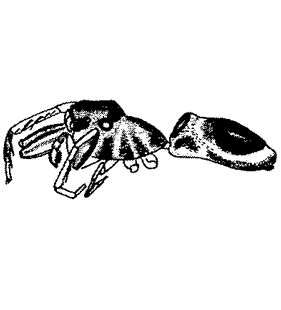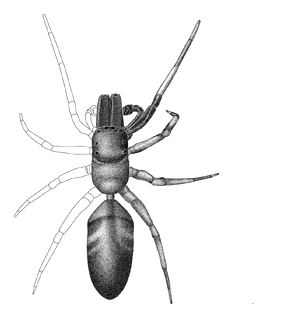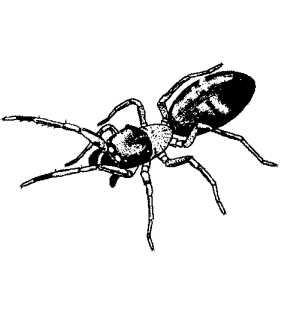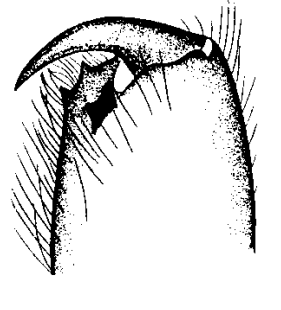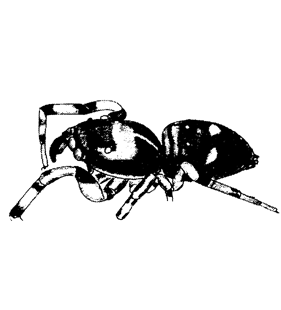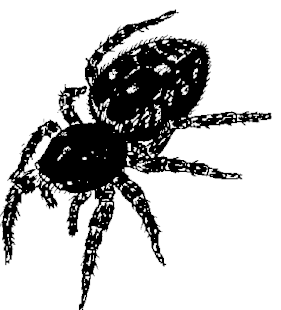|
Key not complete! Further genera listed at the end of key |
In case you find an error or have a specific suggestion, please follow this link: click
|
1
|
Ant-like habitus (opisthosoma long, slender; petiolus clearly visible) 2 |
|
| - |
Spider-like habitus 4 |
|
2
(1) |
Body length > 5 mm 3 |
|
| - |
Body length < 4 mm; prosoma flat, eye region not elevated Synageles
|
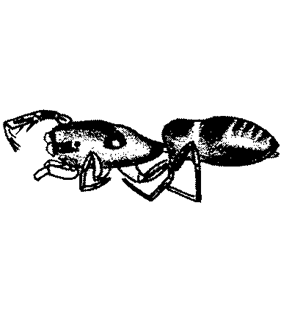 Habitus
(Heimer & Nentwig 1991) |
| |
|
3
(2) |
Eye region elevated, distinctly stepped Myrmarachne
|
|
| - |
Eye region not elevated Leptorchestes
|
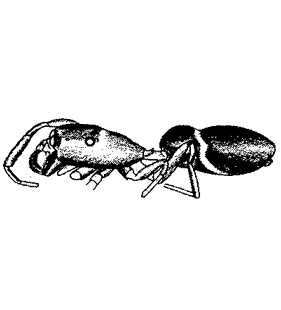 Habitus, lateral view
(Heimer & Nentwig 1991) |
| |
|
4
(1) |
Small species; body length mostly < 3 mm (but compare Attulus caricis); length of the eye region approx. 0.4 of the prosoma length; prosoma low, prosoma height at the posterior median eyes approx. 0.45 – 0.6 of the prosoma length 5 |
|
| - |
Medium-sized to very large species. Body length 4 – 11 mm 8 |
|
5
(4) |
Dark coloured animals, shining metallic surface (males whole body, females only prosoma); male opisthosoma with scutum, female opisthosoma with a soft skin, dark grey; prosoma height approx. 0.45 of its length Chalcoscirtus
|
 Habitus
(Heimer & Nentwig 1991) |
 Habitus
(Heimer & Nentwig 1991) |
|
|
| - |
Body surface not shining metallic; male opisthosoma without scutum 6 |
|
6
(5) |
Pattern of opisthosoma reticulate, dark lines on bright ground, connected to a median angular pattern; eye region > 0.5 of the prosoma length; prosoma height approx. 0.45 of the prosoma length; embolus not spirally rolled up, at its base often small thorns; epigyne with two pits, their margins strongly sclerotised Neon
|
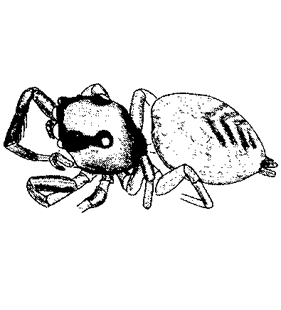 Habitus
(Heimer & Nentwig 1991) |
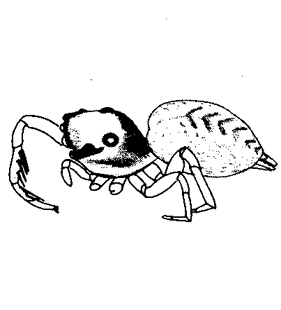 Habitus
(Heimer & Nentwig 1991) |
|
|
| - |
Pattern of opisthosoma with dark angles on bright ground (partly with bright dots) or completely black; eye region > 0.45 of the prosoma length; prosoma height approx. 0.6 of the prosoma length; male pedipalp with a long, spirally rolled up embolus (sometimes hidden); epigyne with bright "windows" 7 |
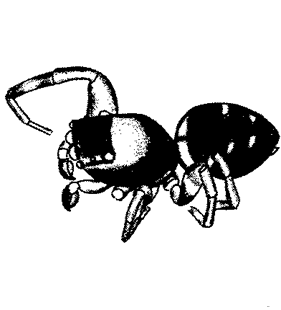 Habitus
(Heimer & Nentwig 1991) |
 Habitus
(Heimer & Nentwig 1991) |
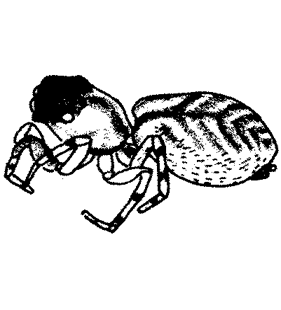 Habitus
(Heimer & Nentwig 1991) |
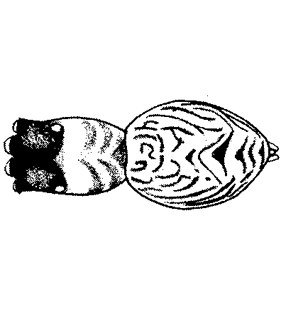 Habitus
(Heimer & Nentwig 1991) |
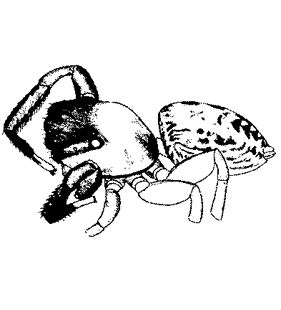 Habitus
(Heimer & Nentwig 1991) |
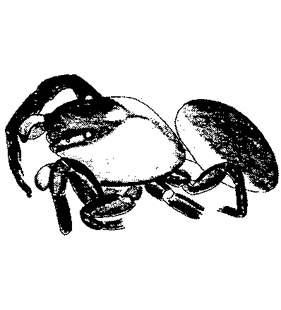 Habitus
(Heimer & Nentwig 1991) |
| | | |
|
7
(6) |
Eye region brighter or whole prosoma brighter; pedipalpal tibia without apophysis; spermathecae round Talavera
|
|
| - |
Prosoma of the same colour; pedipalpal tibia with apophysis; spermathecae not round Euophrys
|
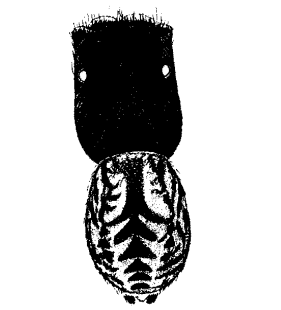  Habitus Habitus
(Żabka 1997)
|
| |
|
8
(4) |
Prosoma as wide as long (in Ballus a bit longer than wide) 9 |
|
| - |
Prosoma clearly longer than wide 12 |
|
9
(8) |
Eye region about 0.5 of the prosoma length; posterior median eyes close to the prosomal margin 10 |
|
| - |
Eye region < 0.5 of the prosoma length; posterior median eyes not close to the prosomal margin; preferably on spruce 11 |
|
10
(9) |
Posterior part of the prosoma wider than anterior part; prosoma surface rough, shining metallic Ballus
|
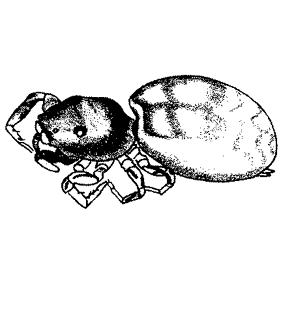 Habitus
(Heimer & Nentwig 1991) |
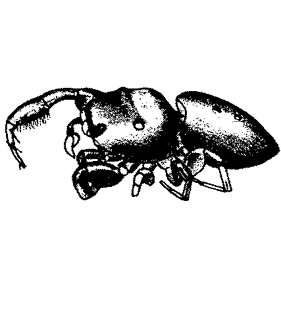 Habitus
(Heimer & Nentwig 1991) |
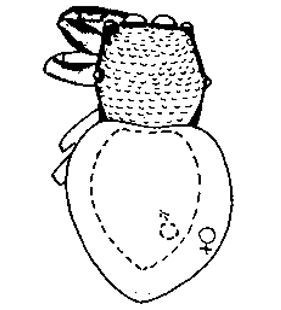 Habitus
(Heimer & Nentwig 1991) |
 |
| |
|
| - |
Posterior part of the prosoma narrower than anterior part; prosoma surface smooth, not shining metallic Bianor
|
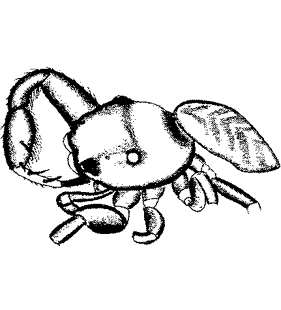 Habitus
(Heimer & Nentwig 1991) |
 Habitus
(Heimer & Nentwig 1991) |
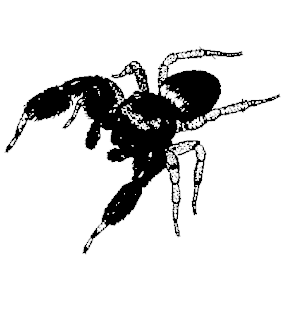 |
| | | |
|
11
(9) |
Opisthosoma pattern laterally with pairs of whitish spots on reddish or greenish ground Dendryphantes
|
 Habitus
(Heimer & Nentwig 1991) |
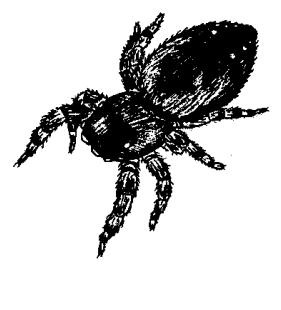 |
|
|
| - |
Opisthosoma pattern laterally with pairs of dark spots on whitish ground; prosoma as fig. Macaroeris
|
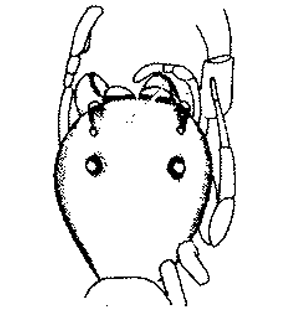 Prosoma
(Heimer & Nentwig 1991) |
 Habitus
(Heimer & Nentwig 1991) |
|
|
12
(8) |
Prosoma flat and long; leg I distinctly longer than legs II-IV (especially in males) 13 |
|
| - |
Different 15 |
|
13
(12) |
Stridulatory organ (a row of thorns on small elevations) below the lateral eyes (corresponding small thorns laterally on femur I); tibia I strongly enlarged, with long, thin sensory hairs Pseudicius
|
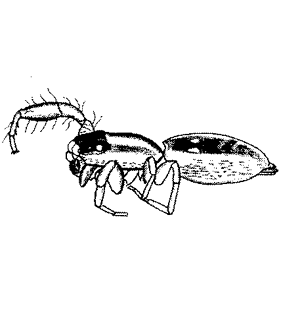 Habitus
(Heimer & Nentwig 1991) |
 |
|
|
| - |
Different 14 |
|
14
(13) |
Prosoma dark, without distinct bright longitudinal stripes; opisthosoma conspicuously long; male pedipalp always with a simple tibial apophysis; epigyne with small depressions in the posterior part; in wet areas, at borders of water or at the sea coast Marpissa
|
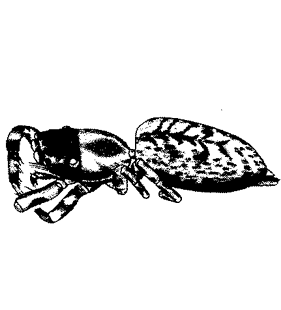 Habitus
(Heimer & Nentwig 1991) |
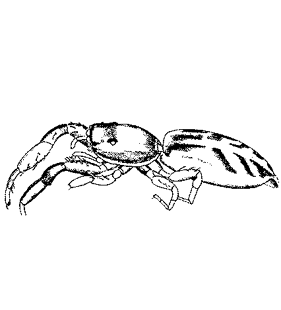 Habitus
(Heimer & Nentwig 1991) |
 Habitus
(Heimer & Nentwig 1991) |
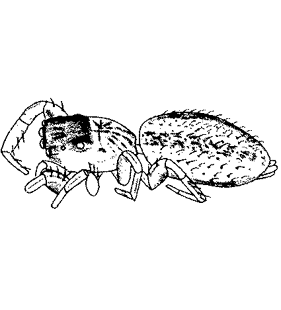 Habitus
(Heimer & Nentwig 1991) |
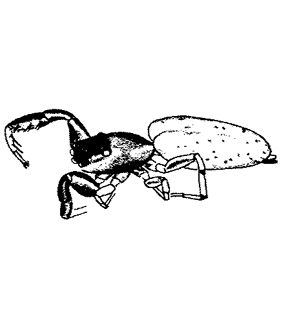 Habitus
(Heimer & Nentwig 1991) |
|
|
| - |
Dark prosoma with distinct bright longitudinal stripes (Phlegra festiva sometimes completely black), similar pattern also on the opisthosoma; male pedipalp always with a forked tibial apophysis; epigyne with very large grooves Phlegra
|
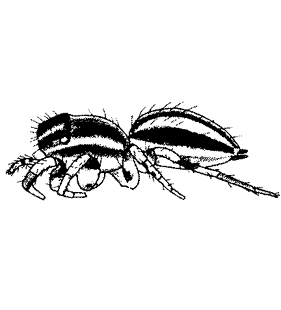 Habitus
(Heimer & Nentwig 1991) |
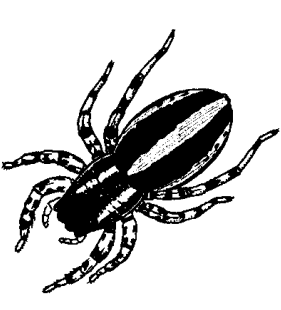 |
|
|
15
(12) |
Prosoma conspicuously elevated 16 |
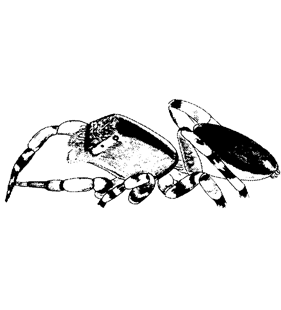 Habitus
(Heimer & Nentwig 1991) |
 Habitus
(Heimer & Nentwig 1991) |
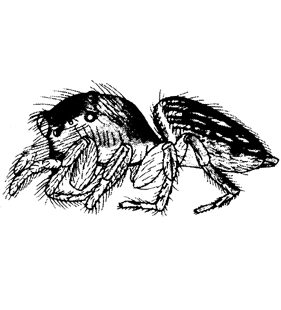 Habitus
(Heimer & Nentwig 1991) |
| | | |
|
| - |
Different 20 |
 Habitus
(Heimer & Nentwig 1991) |
| |
|
16
(15) |
Prosoma ± triangular in lateral view; posterior median eyes on the highest elevation of the prosoma; tarsus I-II with conspicuous large scopulae; one cheliceral teeth, others reduced; on sandy soils Yllenus
|
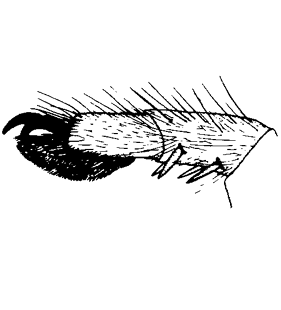 Tarsus I
(Heimer & Nentwig 1991) |
 Habitus
(Heimer & Nentwig 1991) |
|
|
| - |
Different 17 |
|
17
(16) |
Prosoma ± round in lateral view; body densely covered with hairs; dark grey with irregular bright spots; male pedipalp with chisel-like, projecting tibial apophysis; epigyne round to trapezoid with 2 small grooves Carrhotus
|
 Habitus
(Heimer & Nentwig 1991) |
| |
|
| - |
Different 18 |
|
18
(17) |
Male prosoma mostly with white angular pattern in the eye region; opisthosoma grey-black with bright median line Aelurillus
|
 Habitus
(Heimer & Nentwig 1991) |
| |
|
| - |
Different 19 |
|
19
(18) |
Male prosoma black; opisthosoma red wit black median stripe; female opisthosoma black with 2 longitudinal white dots (or stripes) Philaeus
|
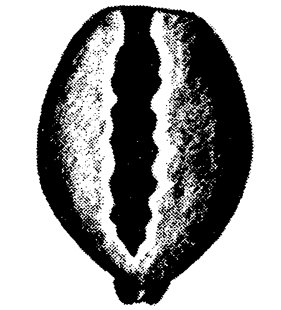 Opisthosoma
(Heimer & Nentwig 1991) |
 Habitus
(Heimer & Nentwig 1991) |
 |
| | | |
|
| - |
Prosoma dorsally with dark orange pattern, lateral lower part orange with white hairs and black margin, upper part dark brown with orange scale hairs; opisthosoma dorsally with yellow-brown dots and angles Neaetha
|
|
20
(15) |
Opisthosoma unicoloured, sometimes with white pattern 21 |
|
| - |
Opisthosoma with irregular dark lines or a mosaic of dark, brown or grey spots of different size, sometimes with white pattern 23 |
|
21
(20) |
Opisthosoma uniformly black, shiny metallic, blue, violet or green; laterally sometimes small white dots in pairs; the anterior opisthosomal margin sometimes with a half-moon-like white line; legs often yellow Heliophanus
|
 Habitus
(Heimer & Nentwig 1991) |
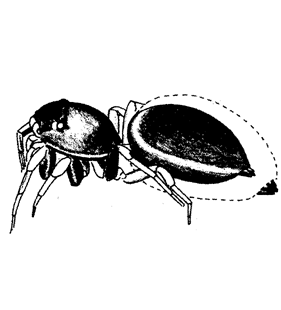 Habitus
(Heimer & Nentwig 1991) |
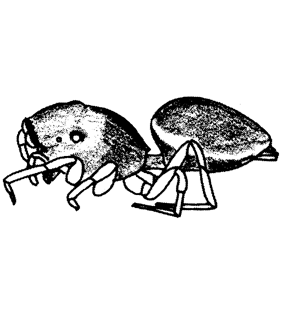 Habitus
(Heimer & Nentwig 1991) |
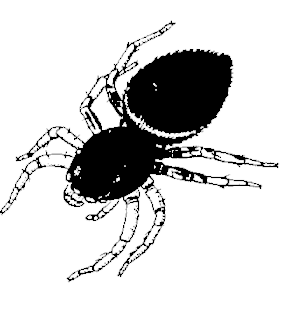 |
| |
|
| - |
Different 22 |
|
22
(21) |
Opisthosoma dark, diagonal or transversal white stripes in pairs, sometimes reduced to dots, no median line Salticus
|
 Habitus
(Heimer & Nentwig 1991) |
 |
|
|
| - |
Opisthosoma black with a distinct white median line, sometimes broken, sometimes 1-2 pairs of white lines on the anterior opisthosomal margin and laterally Pellenes
|
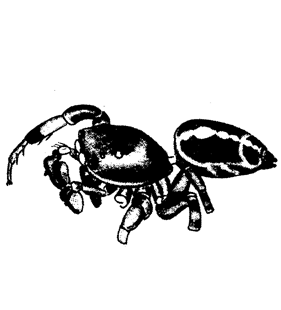 Habitus
(Heimer & Nentwig 1991) |
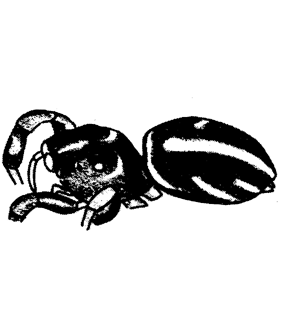 Habitus
(Heimer & Nentwig 1991) |
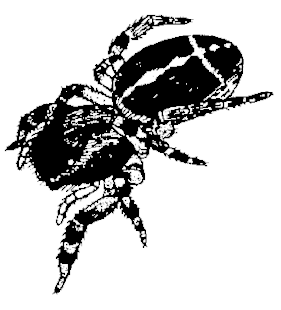 |
| | | |
|
23
(20) |
Opisthosoma with dark, diagonal lines on nearly black ground, sometimes laterally with white stripes Evarcha
|
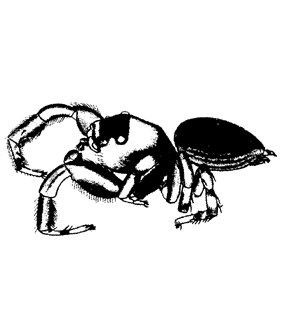 Habitus
(Heimer & Nentwig 1991) |
 Habitus
(Heimer & Nentwig 1991) |
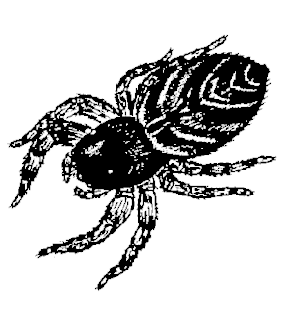 |
| | | |
|
| - |
Opisthosoma with a mosaic-like arrangement of dark, brown, or grey spots of different size, medially mostly with one pair of bright dots or chevrons 24 |
|
24
(23) |
Cheliceral teeth as fig.; tibia of the male pedipalp as long as the bulbus or longer; epigyne with 2 small depressions, their margins half-moon-like sclerotised; in greenhouses Hasarius
|
|
| - |
Cheliceral teeth different; tibia of the male pedipalp not conspicuously long; epigyne different; pattern as fig. Attulus
|
|
| - |
Further genus Saitis
|
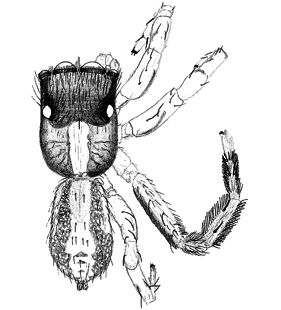  Habitus Habitus
(Metzner 1999)
|
| |
|

